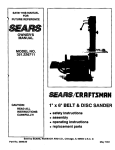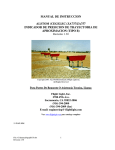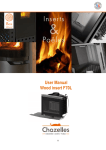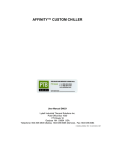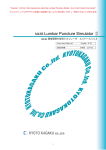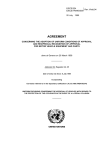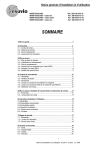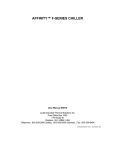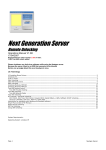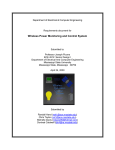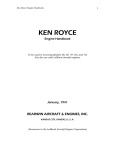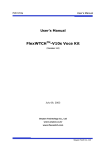Download O ff: 510-249-9100 cell: 650-759-2438 affinity chiller. model RWA
Transcript
Manufacturers of Affinity™ Chillers
affinity chiller.
model RWA-005T-CE01CBD3
Part # 900-34785-000,
Serial # 102699,
Type R-134A.
Pump Motors for affinity:
Marthon carbonator:
5KH32FN5598X (original affinity)
5KH33GNA444X (in NesLabs)
5KH32GNB811X (cheap version)
Chiller Part # 34785
Off: 510-249-9100
cell: 650-759-2438
Lydall Industrial Thermal Solutions Inc.
775 Route 16
Ossipee, NH 03864 USA
Telephone: (Sales) 603-539-3600, (Service) 603-539-5005, Fax: 603-539-8484
www.lydallaffinity.com
AFFINITY™ R-SERIES CHILLER
User Manual 010731
Lydall Industrial Thermal Solutions Inc.
Post Office Box 1000
775 Route 16
Ossipee, NH 03864 USA
Telephone: 603-539-3600 (Sales), 603-539-5005 (Service), Fax: 603-539-8484
O:\MANUALS\010731 REV. A : (08/2712002) RV
Table of Contents
Introduction
Facility Water Requirements
Equipment Precautions
Safety Precautions
Installation
Transporting
Placement
Electrical Requirements
Installing the External Strainer Accessory
Priming the Pump and Connecting the Coolant Loop
Cooling a Water-Cooled Condenser
Operation
Using the Controller
Changing the Set-Value Temperature
Safety Alarms
Preventive Maintenance
Trouble Shooting Guide
Warranty
Refrigeration Diagram
Fluid Flow Diagram
Electrical Schematic
O:\MANUALS\03851 (08/31/2001)
Introduction
•
1y
Congratulations on your purchase of an Affinity™ product.
I want to personally welcome you to the Lydall larger family. In October of 2001, Lydall
purchased Affinity Industries, in an effort to expand capability as a Total Thermal Solutions
Provider. Affinity's chillers and heat exchangers complement Lydall's existing wide array of
Passive Thermal Solutions, augmenting Lydall's engineered thermal solutions for use in
appliance, cryogenic, building products, and automotive markets. Our group is market driven as
a formidable thermal solution manufacturer.
Lydall, Inc. is a New York Stock Exchange listed company (NYSE: LDL) headquartered in
Manchester, CT. Our company, with ten operations in the United States, France, one in
Germany, and Sales/Service Offices in Japan and Singapore, is recognized for working with
customers to satisfy their unique thermal solution needs, and for delivering high quality,
innovative products, and exceptional service.
Affinity™ products are high-precision specialty temperature-controlled equipment. The following
product manual is designed to help you realize the full value of your purchase.
We highly recommend that you read this manual in its entirety. The manual will assist your
company with the installation, operation, and routine maintenance of your Affinity™ product.
Please keep this manual readily accessible to operation and service personnel to ensure you get
the most out of our product.
If you have any questions about this model, or have other thermal solution needs, do not hesitate
to call our Sales department (603-539-3600) or the 24/7 Service department (603-539-5005).
Thank you for your confidence in our ability to meet and/or exceed your needs and expectations.
Sincerely,
John Tattersall
Group Vice President
Lydall Industrial Thermal Solutions, Inc.
O:\MANUALSID3774 (01/11/2002)
Facility Water Requirements
IRWA-oosl
IRWA-0031
1.6
'[ 1.4
OJ
"""'"'"'""""'""""""""""""""""""""'"? , "'
'©'
-ro
1.2
0::
................................................................................ ..........
3
0
0.8
li>
-ro o.6
s
g 0.4
'(3
0.2
0
0
15
25
15
5
35
35
Recommended + Minimum
Recommended • Minimum
IRWA-012 1
IRWA-0011
E'
0..
25
Facility Water Temperature (C)
Facility Water Temperature (C)
2.4
9
Q)
-ro
0:: 1 .6
3
0
u::
1.2
li>
-ro
s
g
'(3
ro
0.8
'iro5 o.5
0.4
LL
LL
0
15
5
25
35
5
15
Recommended • Minimum
25
Facility Water Temperature (C)
Facility Water Temperature (C)
I·
Recommended + Minimum
The model number on the serial tag will indicate which graph references this unit.
25psi Minimum Facility Water Pressure Differential
50psi Maximum Facility Water Pressure Differential
75psi Maximum Facility Water Inlet Pressure
Operating with Minimum Facility Water Flow reduces system efficiency
O:IMANUALS\05035 (06125/1999)
35
Equipment Precautions
Failure to adhere to these precautions will void the warranty and may damage the
chiller.
1.
The chiller has been shipped without coolant. Do not run it without connecting the
coolant lines and keeping them filled with the appropriate coolant. Never run the pump
without prime because it will be quickly damaged without liquid. Keep the fluid in the
reservoir at a satisfactory level to avoid damage to the pump and other components.
2.
Never use coolants which are incompatible with the components in the chiller's coolant
loop. Some coolants may not damage the coolant loop components yet may significantly
derate the chiller's cooling capacity. Never use automotive antifreeze or other
antifreeze containing silicates because they will cause the pump seals to fail.
Check with Lyda II if there are questions about the coolant.
3.
Maximum storage temperature for the unit is 52 °C (125°F).
4.
Heat generated by motors and electrical components must be dissipated. Allow
sufficient clearance around the unit to dissipate this heat.
5.
This chiller is designed for indoor use only. If the chiller has been exposed to
temperatures below 7° C, allow 24 hours at ambient temperatures above 7° C to warm
the oil in the compressor as well as the refrigerant before starting.
6.
If this unit contains refrigerant, there is an oxygen depletion risk that should be
considered. It must be placed in a room with adequate volume based on the amount of
refrigerant in the unit. If additional refrigeration equipment is in the room, additional space
must be provided. In the Placement section, under Installation, refer to the Warning:
Oxygen Depletion Risk for more details.
7.
This chiller exhausts the heat it extracts to Facility Water. The Facility Water should
never exceed 30 °C (86 ° F). The Facility Water flow will be controlled by the water valve
at Lydall's condenser. See the Facility Water Requirements section of this manual for
the exact flow and pressure necessary for this unit.
8.
A water-cooled unit should never be run without the Facility Water connected and
flowing. The unit will quickly sustain damage without Facility Water. This damage is
excluded from warranty.
9.
Routinely inspect the pump inlet strainer located in the reservoir for debris. Turn off the
chiller, then remove the strainer and clean as required to permit free flow of coolant.
Prevent foreign debris from entering the coolant line while the strainer is removed. Hint: A
plastic sandwich bag may be used to wrap the strainer to contain most of the debris.
Failure to keep the strainer clean will reduce the coolant flow and may damage the pump.
1O.
Regularly clean the screen in the assembly at the chiller's inlet for Facility Water. To
clean, turn the chiller off, close off the supply of Facility Water to the chiller and remove
the screen. Clean as needed and reinstall.
Equipment Precautions
11.
Do not operate damaged or leaking equipment.
12.
Do not operate the chiller at coolant temperatures above or below the values it was
specified to deliver.
13.
Do not run the chiller with cooling loads that exceed its factory rated cooling capacity.
14.
The chiller must not be transported unless suitably protected. Original factory packaging
in good condition or equivalent is required. Request air-ride trucks if transporting over
land.
15.
The chiller should be thoroughly drained and the coolant lines blown dry with low
pressure compressed air before shipping or storing.
16.
Modifying the chiller without express written consent from Lydall will void the warranty.
O:IMANUALS\03796 (10/04/2002)
Safety Precautions
1.
Heed all warning labels. Do not remove.
2.
Do not operate the chiller with the bonnet removed. The bonnet protects personnel from
rotating parts and hot surfaces and also protects the chiller's components.
3.
Connect the chiller to a properly fused disconnect box in compliance with the National
Electric Code (NFPA-70) as well as state and local codes for American usage, or local
and national codes for European usage. Maximum fuses must not exceed the maximum
rating found on the serial tag on the electrical box. The voltage, phase, and frequency of
the power source must also match the requirements specified on the serial tag. To
reduce the risk of electric shock:
•
Disconnect electrical power before opening the electrical box, except for
the checking of the phase reverse relay or phase monitor if included with
this unit (phase reverse relays or phase monitors will never be included in
single phase units). Power must be applied in order for the phase reverse
relay or phase monitor to indicate phase sequence.
•
Do not operate with electrical box door open.
•
Refer servicing of electrical box components to qualified/certified
personnel.
•
Do not operate equipment with damaged electrical power cords.
•
Turn off the unit and disconnect electrical power before servicing or
moving.
•
Properly ground the unit.
4.
Coolant lines, filters, and other components which connect to the chiller must be capable
of withstanding the maximum pressure that the pump in the chiller can deliver at the
maximum expected temperature.
5.
The coolant loop has not been designed for potable water applications. Do not use the
chiller for potable water. Never hook the water lines of a water-cooled unit to a potable
water source or immerse a hose connected to a potable water source in the reservoir
without providing back flow protection. A loss of pressure in the water source could lead
to a back flow of the fluid in the unit, resulting in a possible contamination of the potable
water source.
6.
Vapors of some alcohol based antifreezes as well as other coolants may cause
explosion if exposed to flame or spark.
7.
Certain antifreezes may be poisonous if ingested.
O:\MANUALS\03799 (10/03/2002)
Installation
Transporting
An Affinity™ chiller rolls easily on four swivel casters. The brakes must be off on the two locking
casters when moving the unit. Roll the chiller gently to its operating location. The cushioned
casters will help to dampen shock. Lock the casters when the unit is in place. If a forklift will be
used to carry the chiller, proceed slowly and carefully to avoid jarring the unit. Insert the forks
carefully to prevent damage to the casters.
If the chiller will be shipped, protect it from shock and vibration or the warranty will be void. The
chiller must not be transported unless suitably protected. Original factory packaging in good
condition or equivalent is required. Request air-ride trucks when transporting over land.
Drain all coolant lines and blow them dry with low pressure air before transporting or storing the
unit. Lydall will not accept any unit containing measurable amounts of fluid. Fluid left in the unit
during shipping may damage components within the unit. Such damage is not covered by
warranty.
Placement
Select a level location near the application, free from dripping or spraying moisture and
excessive dust. Keep the coolant lines short to allow the pump to provide maximum pressure
and flow to the application. If the chiller will be placed more than 25 feet from the application, call
Lydall to discuss placement and how it might affect performance.
Units with non-pressurized reservoirs should never be installed more than 25 feet below the
process or overflow may occur. Distances may vary slightly due to elevations above sea level.
Call Lydall service (603-539-5005) for more information.
WARNING: Oxygen Depletion Risk
In the event of a refrigerant leak, refrigerant gas may displace oxygen that could result
in suffocation and death. Never place the chiller in a room that is smaller than the minimum
room volume requirement as defined below. If the room is ventilated, the air distribution system
must be analyzed to determine the worst case distribution of leaked refrigerant. A leak detector
alarm device is always required in a ventilated room that does not meet the minimum room
volume given below. Assure adequate and sufficient room volume and ventilation before placing
a chiller that contains refrigerant in a room. Contact Lydall at 1-603-539-5005 if you have any
concerns or questions.
Pounds of refrigerant charge can be read directly from the nameplate on your chiller.
Remember to include in your calculation any refrigerant that may be stored in any other
containers.
Minimum Room Volume = Pounds of refrigerant x 110 cubic feet
Example: Two chillers are placed in a room, each containing 6 pounds of refrigerant. The
minimum room volume shall be 12 x 110 cubic feet, or 1,320 cubic feet.
Installation
Electrical Requirements
Connect the chiller to a properly fused disconnect box in compliance with National Electric Code
(NFPA-70) as well as state and local codes for American usage, or national and local codes for
European usage. Maximum fuse sizes in the disconnect box must not exceed the maximum
ratings specified on the serial tag of the chiller (found on the electrical box). The voltage, phase,
and frequency of the power source must also match the requirements specified on the serial
tag.
Note: Affinity™ models that can operate at either 208-230 Volts 60 Hertz or 200 Volts 50 Hertz
have been set at the factory for 200-220 volt operation. If the operating voltage will be greater
than 220 Volts, a qualified electrician should remove the red wire from the contactor and replace
it with the orange wire taken from the dummy fuse block. Attach the red wire to the dummy fuse
block (see diagram below). All voltages may not be compatible with this unit. See the unit's
serial tag for the proper voltage range.
TYPICAL CONFIGURATION
ELECTRICAL SCHEMATIC
(
l
CONNECT FOR :
SYSTEM VOLTAGE I
I
CT1
75VA
BLUI
NOTE: IN SOME CASES PRESS URE SCREW TERMINAL BLOCKS
ARE USED IN PLACE OF FASTON TERMINATIONS
&
L--r
vnv YEL
I
Warning: To reduce the risk of electric shock, do NOT remove cover from the
electrical box. It contains exposed high voltage wires. Refer servicing to qualified
personnel. Disconnect power to the chiller before servicing
Installing the External Strainer Accessory
The strainer accessory comes with extra fittings to allow arrangement in different configurations.
Any combinations of these fittings is acceptable. Lydall recommends that the strainer be
installed on the Facility Water inlet port.
lnstal lation
The strainer requires a regular maintenance schedule. Frequency will be based on the
application and the cleanliness of the fluid, which can vary greatly. Failure to regularly check the
strainer may result in poor performance and/or unit failure.
Priming the Pump and Connecting the Coolant Loop
DO NOT RUN THE PUMP DRY. If the pump does not establish prime, the pump shaft seal may
overheat and be damaged in less than a minute. Use the following instructions when filling and
assembling the coolant lines to prevent damage to the pump shaft seal.
1.
Close the reservoir drain.
2.
Fully open the flow control valve (if included).
3.
Have extra coolant to add as the pump primes and the coolant loop fills.
4.
Fill the reservoir with coolant. Do not fill above the height of the coolant loop connection
fittings or fluid may leak out.
5.
Connect the coolant lines from the application to the FPT (female pipe thread) fittings
near the top of the chiller as follows. Do not over tighten the insert and do not use a
sealant that will lock the male threads to the female threads.
a.
Connect the coolant line coming back from the application to the RETURN fitting.
b.
Connect the coolant line going to the application to the SUPPLY fitting.
RETURN
SUPPLY
6.
When the previous steps are complete, turn the chiller on by placing the ON/OFF/SET
switch in the ON position. Immediately check for flow. If within five seconds no
turbulence is visible in the reservoir or the supply pressure gauge shows no pressure
reading, shut the chiller off by placing the ON/OFF/SET switch in the OFF position. If
flow is established, continue filling until the reservoir low level alarm shuts off. Do not
allow the reservoir to overflow.
7.
If the pump does not establish prime, disconnect the SUPPLY coolant line to vent any
trapped air, reconnect the line, and repeat step 6.
Installation
8.
If the pump still does not prime, use the following steps:
a.
Disconnect both coolant lines (have a container handy to catch any overflow from
the RETURN fitting).
b.
Force coolant into the SUPPLY fitting. The fluid will force the air out of the lines in
the chiller and out of the pump head, causing it to escape into the reservoir. If tap
water will be the source of coolant, simply connect the tap water line to the
SUPPLY fitting and turn on the tap. If a source of coolant other than tap water will
be used, elevate the coolant a few feet above the chiller, connect to the SUPPLY
fitting, and let gravity force the air out into the reservoir. Remember to have a
container handy to catch any overflow from the RETURN fitting.
c.
Reconnect the coolant lines and repeat step 6. Stop filling when the reservoir is
full to within a few inches of the top. Do not allow the reservoir to overflow.
A stainless steel mesh strainer attaches to the pump suction port near the bottom of the
reservoir. It can easily be removed for cleaning. First turn the pump off, then pull off the strainer,
rinse it clean, and push it back on. To protect the pump, routinely inspect the strainer to be sure
it is clean and properly attached. Hint: If the strainer is coated with debris, wrap it with a plastic
sandwich bag before pulling it off to prevent most of the debris from escaping into the reservoir.
Cooling a Water-Cooled Condenser
Never hook a water-cooled unit to a potable water supply without providing back flow protection.
A pressure drop in the water supply could cause back flow, resulting in the possible
contamination of the potable water supply. Water-cooled chillers require Facility Water to cool
the condenser during operation. The amount of flow is controlled automatically by a valve Lydall
installs on the condenser. See the Facility Water Requirements section of this manual for the
specific flow, temperature and pressure needed for this unit. Failure to connect Facility Water to
the unit and supply the correct amount of flow may severely damage the unit in an extremely
short period of time.
Connect the Facility Water Supply to the WATER IN fitting at the bottom of the chiller; and
connect the Facility Water Return to the WATER OUT fitting. Use connecting lines of the size
indicated on the coolant diagram (inside diameter) to reduce pressure loss.
Note: The coolant lines of all water-cooled chillers have been blown dry with low pressure air
before shipping to protect the units from freezing and subsequent damage. This may cause the
condenser to be dry which, in turn, could result in failure to start upon initial start-up (there could
be no water in the condenser to absorb the heat). This is easily corrected by pressing the high
pressure reset switch a few times to initiate flow through the Facility Water side of the chiller.
O :\MANUALS\010685 (07/25/2002)
Operation
Using the Controller
This Affinity TM chiller comes standard with a FUJI 1/16 DIN temperature controller. This
controller is a programmable microprocessor, which offers many more features than are
necessary to master at this point. If more than the basic instructions provided in this manual will
be needed, consult the FUJI Instruction Manual or call Lydall service (603-539-5005) for technical
assistance.
oc
Affinity
co
HO
LQ
::C> I s-1 s.
/\
PV/SV
SEL
DATA
....
/\
ENT
Place the ON/OFF/SET switch on the control box (if included with this chiller) or the chiller's
control panel near the Fuji controller in the SET position. SET activates the control display but
does not turn on the refrigeration and pump systems of the chiller. Four dots will appear on the
display, then in 3-4 seconds the temperature of the coolant will appear plus an indicator light next
to PV. Indicator lights next to C, H, or L may also appear. The function of these lights will be
discussed later in the section on Safety Alarms.
Press PV/SV until the indicator light appears next to SV to display the Set-Value temperature.
The Set-Value temperature can be changed to any temperature within the range programmed
for this Affinity™ model. Note: Pressing PV/SV allows toggling the indicator light between PV,
the actual process coolant temperature, and SV, the Set-Value temperature.
Changing the Set-Value Temperature
Change the Set-Value temperature by pressing PV/SV until the indicator light appears next to
SV. Then directly under the digit in the display to be changed, press (/\)and the digit will start
blinking. To increase the digit value, press (/\) under the blinking digit as many times as
necessary. To decrease the digit value, press (V) at the left side of the controller. Press (/\)
under the next digit value to be changed and repeat the process. When all the digits are set to
the desired value and with one digit still blinking, press the red (ENT) key at the far right of the
controller to enter the new Set-Value temperature.
Operation
A display of letters or numbers which do not indicate temperature may appear. SEL or DATA
was probably inadvertently depressed. The FUJI Instruction Manual explains the use of SEL and
DATA functions which are used solely in setting the basic program of the microprocessor. Press
PV/SV to return to either the PV or SV display.
The controller comes pre-programmed according to the Affinity™ model selected . If the
additional features programmed into the controller will be needed, consult the FUJI Instruction
Manual, or call Lydall service for technical assistance. The highest and lowest SV programmed
into the controller depends upon the model selected.
Caution: Never program in a Set-Value temperature of more than 32°C (90 ° F) unless this
Affinity™ model is specially modified to operate at higher coolant temperatures. Never program
in a Set-Value temperature of less than 5°C (40°F) unless a suitable antifreeze is used as
coolant, AND the chiller is set to operate at below freezing temperatures.
Turn the whole system on by placing the ON/OFF/SET switch in the ON position. The Set-Value
temperature can be changed with the switch in either the ON or SET position.
Air bubbles will be visible rising in the reservoir as the pump forces air out of the coolant loop.
After the air has been purged from the coolant loop, a steady turbulence may be seen in the
reservoir. This turbulence mixes the coolant to deliver more precise temperature stability in the
coolant supply than the controller indicates.
Safety Alarms
The "LOW LEVEL" indicator light and the corresponding audible alarm actuate when the coolant
level in the reservoir is low and needs to be replenished. This indicator light does not actuate
with the ON/OFF/SET switch in the SET position.
The "FAULT" light comes on if too little coolant is circulating through the heat exchanger. The
"FAULT" light comes on momentarily upon start-up until the pump establishes sufficient flow.
The "FAULT' indicator does not actuate with the ON/OFF/SET switch in the SET position.
If the "FAULT" light remains on for more than a few seconds, the chiller should be turned off and
the reason for loss of circulation determined and corrected.
Caution: Although the "FAULT" light alerts the operator that no coolant is flowing, the operator
must not assume proper circulation through equipment external to the chiller if the light does not
appear. A bypass system built into the chiller to protect the pump may satisfy circulation
requirements within the chiller even though flow outside the chiller is blocked. For example,
turning the flow control valve on the chiller to no external flow does not actuate the light; similarly,
a wheel of a forklift truck standing on an external cooling line, thus stopping the flow to the
application, will not actuate the fault light.
Operation
The FUJI controller on this chiller has HIGH and LOW TEMPERATURE ALARM LIGHTS: H and
L appear just under the Affinity™ logo at the top of the controller. At the factory, a technician has
programmed the alarm light to come on under H if the circulating coolant is above the
temperature that this chiller has been set to deliver. The alarm light under L is programmed to
come on if the circulating coolant is below the temperature the chiller has been set to deliver.
Consult the factory if it is necessary to operate above or below these limits.
The light on the FUJI controller next to C, when lit, indicates that the refrigerant solenoid valve is
open to allow refrigerant to flow to the heat exchanger. If the light is on most of the time, most of
the capacity of the chiller is in use. If the light is on infrequently, much less than the full capacity
of the chiller is being used.
Preventive Maintenance
A stainless steel mesh strainer attaches to the pump suction port near the bottom of the
reservoir. It can easily be removed for cleaning. First turn the pump off, then pull off the strainer,
rinse it clean, and push it back on. To protect the pump, routinely inspect the strainer to be sure
it is clean and properly attached. Hint: If the strainer is coated with debris, wrap it with a plastic
sandwich bag before pulling it off to prevent most of the debris from escaping into the reservoir.
The frequency of checking and cleaning this strainer will depend on the cleanliness of the
process and the fluid.
The Facility Water strainer requires a regular maintenance schedule. Frequency will be based
on the application and the cleanliness of the fluid, which can vary greatly. Failure to regularly
check the strainer may result in poor performance and/or unit failure.
Check the strainers a week or two after starting the unit, then develop your own schedule for
checking and cleaning the strainers based on experience.
Decommissioning
Decontamination procedures are not required or applicable as there are no hazardous materials
used within this unit. The refrigerant used in this unit is environmentally friendly (a non-ozone
depleting HFC) and poses no hazard to the environment. However, the refrigerant must be
recovered by a qualified refrigeration service technician in accordance with all applicable laws.
When decommissioning, remove all fluids by opening all drains and placing the fluid in
appropriate containers. After all flow has ceased, purge the lines with low pressure air.
The unit is comprised of metals that may be recycled. The significant metals which make up the
unit are as follows:
+
Cold-rolled steel
+
Stainless steel
+
Copper
There are no significant amounts of plastics or other materials incorporated into this unit.
Recycle metals appropriately.
O:\MANUALS\08574 (05116/2002)
Trouble Shooting Guide
Problem
Unit does not
start
Unit does not
cool
Possible Cause
Possible Remedy
No power to unit, breaker tripped
Verify supply power is on, close
breaker after correcting fault
Low voltage
Check electrical service to unit
High pressure cut-out tripped
Will automatically reset after
correcting fault
Loose wire
Check wiring after disconnecting
power
Defective contactor or coil
Repair or replace contactor or coil
Loss of refrigerant
Repair leak, recharge with type and
amount of refrigerant specified on
serial tag
Compressor damaged
Replace - Call Lydall
Compressor internal thermostat
tripped
Allow time for compressor to cool to
automatically reset
Compressor damaged
Replace compressor - Call Lydall
Facility Water control valve set too
low
Reset Facility Water control valve
Facility Water too warm
Provide cooler Facility Water
Evaporator damaged
Call Lydall
Microprocessor failure
Replace microprocessor
Cooling load exceeds capacity of
unit
Reduce cooling load
Microprocessor programmed
incorrectly
Reprogram microprocessor - Call
Lydall
Loss of refrigerant
Locate and repair leak, recharge
with type and amount of refrigerant
specified on serial tag
Problem
Unit does not
cool
(continued)
Pump leaks
Noisy
compressor
Possible Cause
Possible Remedy
Refrigeration solenoid coil failure
Replace solenoid coil
Solid State Relay failure
Replace Solid State Relay
Solenoid valve stuck shut
Repair or replace solenoid valve
Defective refrigeration low pressure
cut-out
Repair or replace refrigeration low
pressure cut-out
Malfunctioning thermal expansion
valve
Replace thermal expansion valve
Pump damaged, loss of flow
Replace pump
Hot gas bypass valve setting too
high
Call Lydall
Hot gas bypass valve stuck open
Repair or replace valve
Faulty pump casing
Replace pump assembly
Shaft seal damaged
Replace shaft seal
Pump housing 0-Ring damaged
Remove pump and rebuild
Improper fluid
Call Lydall
Flooding of refrigerant into
crankcase
Warm crankcase if unit has been off
for a long period or has been left in a
cool ambient for more than a few
hours
Worn compressor
Replace compressor - Call Lydall
Refrigeration high pressure cut-out
set too high
Adjust setting
Refrigeration low pressure cut-out
set too low
Adjust setting
Problem
Excessive
noise on StartUp
Possible Cause
Possible Remedy
Low voltage
Check electrical service
Wrong voltage taps used on
transformer
Connect to proper taps
Contactor or coil failure
Replace contactor or coil
Pump motor
overheats
Improper voltage supplied
Correct voltage
Level light
remains on
Low coolant level in reservoir
Check for leaks, then fill reservoir
Reservoir level switch float stuck
Clean reservoir and level switch
Time delay relay malfunction (when
used)
Replace time delay relay
Level switch failure
Replace level switch
Time delay relay has not timed out
(when used)
Wait for time delay to time out
Lamp burned out
Replace lamp
Level switch failure
Replace level switch
Pump suction strainer clogged
Remove strainer, clean and reinstall
or replace
Flow control valve not fully open
Open flow control valve
Pressure relief valve set too low
(unless not adjustable)
Adjust pressure relief valve to
specification
Low coolant level in reservoir
Fill reservoir to proper level
Restriction in coolant lines external
to chiller
Eliminate restrictions in coolant
lines external to chiller
Frozen evaporator
Call Lydall
Flow switch clogged
Disassemble flow switch, clean and
reinstall or replace
Level light does
not work
Low coolant
flow
Problem
Fault light
remains on
No coolant flow
Chiller shuts
down during
operation
Possible Cause
Possible Remedy
Low coolant flow
See Problem: Low coolant flow
No coolant flow
See Problem; No coolant flow
Flow switch stuck
Disassemble flow switch, clean and
reinstall or replace
Pump not primed
Prime pump
Pump suction strainer clogged
Remove and clean strainer, then
reinstall
No coolant in reservoir
Check for leaks, then fill reservoir
Pump overload tripped
Wait 5 minutes for overload to reset
Pump motor shaft bound to seal
Replace pump or renew seal
Pump housing improperly torqued
Remove pump, torque to
specification, test, and reinstall
Damaged pump
Replace pump
Frozen evaporator
Call Lydall
Clogged line or closed valve in
external piping
Check external piping for dirt or
closed valve
Leak(s) in external piping
Check for leaks and repair as
needed
Refrigeration high pressure cut-out
set too low
Adjust and reset refrigeration high
pressure cut-out
Refrigeration low pressure cut-out
set too high
Adjust and reset refrigeration low
pressure cut-out
Excess refrigerant charge
Remove excess refrigerant and
recharge to specifications on serial
tag
Problem
Chiller shuts
down during
operation
(continued)
Temperature
display reads
incorrectly
Chiller cools
well below the
desired SetPoint
Too much
recirculating
pressure to
process
Compressor
turns on and off
automatically
Possible Cause
Possible Remedy
Pump thermal overload setting too
low
Adjust and reset thermal overload
relay to specifications, replace if
faulty
Facility Water too warm
Provide cooler Facility Water
Pump overload tripped
Determine reason for trip, if pump is
damaged, repair or replace
Low voltage
Check electrical service to chiller
Loose wire
Check wiring after disconnecting
power
Broken RTD
Replace RTD
Microprocessor failure
Replace microprocessor
Microprocessor programmed
incorrectly
Reprogram microprocessor - Call
Lydall
Malfunctioning solenoid valve
Repair or replace solenoid valve
Solid State Relay failure
Replace Solid State Relay
Microprocessor failure
Replace microprocessor
Flow control valve set too high
Throttle flow control valve
Pressure relief valve set too high
(unless not adjustable)
Adjust pressure relief valve
Discharge pressure too high
Check Facility Water for blockage
Condenser fan(s) not on
Check motor(s) and wiring
Refrigeration high pressure cut-out
set to automatic
Check settings
Problem
Compressor
does not run
Microprocessor
does not work
O:\MANUALS\03629 (07/11/2002)
Possible Cause
Possible Remedy
Compressor internal thermostat
tripped
Allow time for compressor to cool
and automatically reset
Motor burned out
Replace - Call Lydall
5 second delay has not timed out
Wait at least 5 seconds after turning
on
Microprocessor programmed
incorrectly
Reprogram microprocessor Call Lydall
Microprocessor failure
Replace microprocessor
Warranty
The Lydall Limited Warranty
Twelve-Month Warranty
Parts and Labor
Lydall Industrial Thermal Solutions Inc. warrants this product to the original Owner for a period
of twelve (12) months from the date of shipment. Lydall will repair, or, at its discretion, replace
any part found to contain a manufacturing defect in material or workmanship, without charge to
the Owner, for twelve months from date of shipment. Shipping costs will be excluded from
warranty. Service labor will be at no charge during the warranty period as long as the labor is
supplied at the Lydall plant in Ossipee, New Hampshire, or by a Lydall approved service
provider. Replacement or repaired parts will be warranted only for the un-expired portion of the
original Warranty. To obtain prompt warranty service, contact Lydall, PO Box 1000, Ossipee,
New Hampshire, 03864, USA.
Before returning any equipment to Lydall for repair, it is necessary to contact the Lydall Service
Department for a Return Material Authorization number and an authorized service depot
location where the repairs will be completed.
This Warranty does not cover the following: Damage or failure of any part caused by accident,
customer shipping, storage, misuse, customer modification, fire, flood, Acts of God, or resulting
from failure to properly install, operate, or maintain the product in accordance with the printed
instructions provided in the User Manual. As noted in the User Manual, any modification of the
unit without expressed written consent from Lydall will void the warranty.
In no event shall Lydall be liable for any repairs or service or any consequence of any repair or
service that are not performed in strict accordance with all applicable city, county, state, and
federal laws.
Further limitations and exclusions: This Warranty is in lieu of any other warranties, expressed or
implied, including merchantability or fitness for a particular purpose. In no event shall Lydall be
liable for any consequential or incidental damages that the Owner may incur resulting from
purchase or use of this Lydall product. The buyer's sole and exclusive remedy and the liability
limit of Lydall, for any loss whatever, shall not exceed the purchase price paid by the purchaser
for the Lydall product on which a claim is made.
Lydall Industrial Thermal Solutions Inc.
Post Office Box 1000
775 Route 16
Ossipee, NH 03864 USA
Telephone: 603-539-3600 (Sales), 603-539-5005 (Service), Fax: 603-539-8484
F:IMANUALS\03777 (04/27/2005)
11115 / 97Cfll
EVAPORATOR
PROCESS
COOL! NG
IN
PROCESS
COOL ING
OUT
HIGH DISCHARGE/
LO\'/ SUCTION
PRESSURE S\'/I TCH
'\.,o_ - - + - - - - - ---HIGH LOW
EXPANSION
I\
HOT GAS BYPASS
VAL VE
CONDE ISER
SOLENOID
VALVE
\I
I\
SIGHT
GLASS
RECEIVER
DR [ER/FILTER
G·N
DRS RI.A 11// DUAL PS
RDTOLDCK
01319
1or1
NT£:
17115 / 97
e
THIS ro:u•'EJIJ
Pi?!YUH1 CF UOJll
J'.W'StP. P l
SO.UTJQ•,) Ir •.: ..
OISCtO:s.tFt
Ill
CR IN PA.qf rs
fCF.Ol((iEJl 'JI THCiJT
LYDALL
INDUSTRIAL THERMAL SOLUTIOHS
OSSIPEE OPERATION
mRcun 16 . P.a. eo< 1C1n .
oist.4
TeL 1toll m-W)5 . fo(. 1£031 5n-mo
A CREATED CID ORIYJl,r,
6/16103 (-h'I
PROCESS COOL IlIG
1
11z"
RE
1
12"
FPT
l
FPT
SUPPLY '
\/
REFRIGERATION
OUT
REFRIGERATION
ADJUSTABLE
PRESSURE BYPASS
EVAPORATOR
'--'
TEMPERATURE
SENSOR
FLO\'/
S\'/I TCH
PRESSURE
RELIEF
VALVE
LOI'/ LEVEL
S\'11 TCH
PRESSURIZED
RESERVOIR
DRAIN COCK
GHI
DCS ROB ER-PSPF 38-A PVC
1
or
CHE.i
1
6/26/ Q]
s
THIS CV:U1£Ul
l'·XISTF!lll l!<OW!l Sll.UTl(i•,s II:•: ..
OllClOIU'E 01 Fffi'OO.(l!O•J
lll>c(l.E011•PARlll
D11996
r01a1o:rn •Httt>J T
INDUSTRIAL THIRMAL SOLUTIONS
OSSIPEI OPERATION
77S PUllTE 16. P.O. BO< 1((.0, CJSS IPH . Ml
Tel. wni HMM . FO t. { £.!)]) Sl1-1H&
rn
A
208-230 VOLT . SINGLE PHASE . bO Hz .
200 VOLT , SINGLE PHASE , 50 Hz .
LEGEND:
@
\'/IRE COLORS • PRIMARY COLOR/TRACER OR f.1ARl<ER COLOR
CD • COMPONENT TERMINAL
D • TERMINAL BLOCK
AR • ALARM RELAY
• l.!OTOR CONT ACTOR
CT • CONTROL TRANSFORMER
CR • CONTROL RELAY
FU • FUSE
OL •
OVERLOAD PROTECTION
TC • TWPERATURE CONTROLLER
@
BLK C·Rll BLK
RI
CON
BLK
BLK
BLK
GRll
RED
CTI
40VA
R
24 VAC
ON
OFF
SET
T
LK
YEL
BLU
COMPRESSOR
v
(-----co-11-suci-_1_a_i;-----,:
2
VIO
Pill #2
: Q
1
''81
: HIGH DISCHARGE PRESS :
:'14'
fjp
@i :
I
BLU
Q
Pill 115
!
HIGH
;
- - - - - - - - - - -- - - - - - - - ------__ ,,
____: _:___
LO\'/ LEVEL
Rll
YEL
LOW LEVEL
Pill 111
TC!
Al!T
PHI 114
YE LI RED
TEMPERATURE
CONTROLLER
v0
o1HT
Pill t3
LO\'/ FLO\'/ Pill
i1b
REFRIGERATION
SOLENOID
(i) SSR 1
r;;-.,
Pill
___
;10
/]
30 VOLT AC/DC 1 At.IP MAX,
OTT
""'
4/JO/OJ
DES R TB 15 FL IP
25P FIT IL
079788
rH!I
WJ!.l!,S ft·E
tit l
lf,!XJSTRln 119\i!l SCUT!(;',S u;c . .
Ft.Frt((•l'n!M
lll'JHC!.[M lf1 PJC!T JS
FefaltrOUlllTHJJT
F"IOO CCMEtH .
lYDALL
INDUSTRIAL THERMAL SOLUTIONS
OSSIPEE OPIRATION
175FOJTE16. P. o.w<10C1) , QSSIPEE.t..10m4
Tai. !t03l
ra . . 1£0H5 JHIEt


























